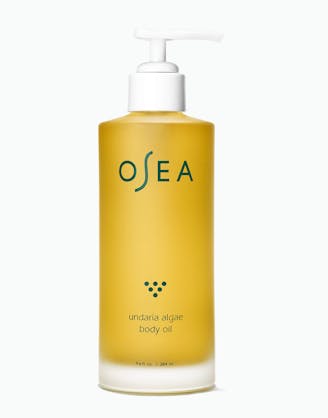Written by OSEA Staff | Updated April 9, 2025
Social media might have you thinking that dry brushing your skin is something new. Despite celebrities hopping on the trend, it’s actually an ancient ritual that dates back over 5,000 years1.
What is dry brushing? It’s the practice of using a natural-bristle, sisal body brush to stimulate circulation, encourage lymphatic flow, and exfoliate skin. Dry brushing is an important part of Ayurveda, a type of holistic medicine from India.
Ayurvedic medicine is based on the principles of balance to maintain optimal health and includes a variety of therapies, including herbal medicines, yoga, and massage to achieve that goal. Practitioners believe that dry brushing can help reduce the body’s response to stress and curb inflammation. Although specific health benefits are still being studied, there’s no doubt that including dry brushing in your skincare routine can help you look and feel your best, with soft, healthy, and glowing skin.
If you’re new to this practice and want to know how to dry brush your skin safely and for the maximum benefits, discover the proper technique and benefits below.
A Beginner’s Guide to Dry Brushing
Before we get into how to dry brush, it’s important to note that it’s not ideal for everyone. If you have a skin concern like eczema, psoriasis, or rosacea, dry brushing is likely to increase skin irritation2.
If your skin can stand up to the exfoliation, try adding dry brushing to your skincare routine once or twice a week. Invest in a body brush with firm, natural bristles, like our Plant-Based Body Brush, an eco-friendly option that’s gentle on your skin. We recommend brushing bare, dry skin just before or after a shower.
Proper dry brushing technique is to use gentle, circular strokes with the brush. Avoid applying too much pressure. You want to gently stimulate your skin and remove the top layer of skin cells without scratching it. Dry brushing should never hurt!
How to Dry Brush at Home
1. Work from the Bottom Up
Start at your feet, making small strokes at the bottom of one foot. Then, start working on the top of one foot and up your leg from ankle to thigh. Use short, gentle strokes and cover both the front and back of your leg. When you get to the hip, switch legs and repeat the same process.
2. Move to Your Back
Brush your hips and lower back, working upward. Spend a little extra time on the sacrum (your lower back) to invigorate your organs in that area, then brush as far up your back as you can comfortably reach.
3. Brush Your Torso and Work Toward Your Heart
Brush the front of your torso from your belly to your clavicle. Work in sections, starting with your abdomen to your chest then your chest to your collarbone. Brushing in the direction of your heart is said to stimulate lymphatic drainage and blood flow3. You may also see recommendations to brush in circular motions around your abdomen to mimic digestion2.
4. Continue Brushing Along Your Arms
Move your attention to your arms, brushing from your wrist to your shoulder. Start with your finger and the back of your hand, then your palm. Brush the front and back of your arm from wrist to shoulder, then repeat with the other arm.
5. Work Gently Around Your Head and Neck
Finish dry brushing with your neck. Use downward strokes from your chin and jaw to your collarbone and the back of your neck from the hairline to your upper back. If you have acne-prone skin, you may want to skip brushing near your face to prevent irritation2.
How to Care for Your Skin After Dry Brushing
Exfoliating your skin with a dry brush primes it for hydration. Follow the self-care session with a rich moisturizing ritual. Indulge your skin with our fast-absorbing Undaria Algae™ Body Lotion. Follow up with mineral-rich Undaria Algae™ Body Oil to lock in hydration for a silky, glowing finish.
Get everything you need for radiant skin when you pick up our Total Glow Body Trio. In addition to our Plant-Based Body Brush and Undaria Algae™ Body Oil, you’ll get the Salts of the Earth Body Scrub, a gentle exfoliator to use between dry brushing sessions that buffs and nourishes in a single step.
How to Care for Your Brush
Remember to take care of your dry brush, too — the bristles can become coated with skin cells after a few sessions. A quick dip in soapy water and gentle scrub with a makeup brush cleaner will keep the brush clean and sanitary4. To keep your brush in excellent condition, avoid getting the base of the bristles and the wood wet. Let the fibers dry thoroughly before the next use, and you’ll dare to bare your gorgeous glowing skin.
Sources
¹ Heiser, C. (May 13, 2024). The Benefits of Dry Brushing and How to Try It. Shape. Retrieved December 18, 2024, from https://www.shape.com/benefits-of-dry-brushing-and-how-to-dry-brush-skin-6825284
² Dweck, S. (July 19, 2023). What Is Dry Brushing? Everything You Need to Know About the Glow-Inducing Method. Town & Country. Retrieved December 18, 2024, from https://www.townandcountrymag.com/style/beauty-products/a44588346/dry-brushing-benefits/
³ Moné, K. (May 31, 2021). Your Complete Guide to Dry Brushing (The Secret to Smoother, Firmer Skin All Over). Ipsy. Retrieved December 18, 2024, from https://www.ipsy.com/blog/dry-brushing-skin
⁴ Schneider, J. (October 13, 2024). Should You Clean Your Dry Brush? Here's What You Need To Know. MindBodyGreen. Retrieved December 18, 2024, from https://www.mindbodygreen.com/articles/should-you-clean-your-dry-brush-how-to-scrub-and-how-often-common-mistake
 Body Oil
Body Oil
 Body Moisturizers
Body Moisturizers
 Cleansers
Cleansers
 Body Scrubs
Body Scrubs
 Face Moisturizers
Face Moisturizers
 Travel & Sets
Travel & Sets





